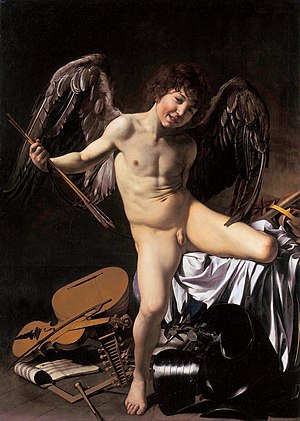Amor Vincit Omnia (Caravaggio)
| Amor Vincit Omnia | |
|---|---|
| Italian: Amor vincitore | |
 |
|
| Artist | Caravaggio |
| Year | 1601–1602 |
| Medium | Oil on canvas |
| Dimensions | 156 cm × 113 cm (61 in × 44 in) |
| Location | Gemäldegalerie, Berlin |
Amor Vincit Omnia ("Love Conquers All", known in English by a variety of names including Amor Victorious, Victorious Cupid, Love Triumphant, Love Victorious, or Earthly Love) is a painting by the Italian early realist / post-Mannerist artist Caravaggio.
Amor Vincit Omnia shows Amor, the Roman Cupid, wearing dark eagle wings, half-sitting on or perhaps climbing down from what appears to be a table. Scattered around are the emblems of all human endeavours – violin and lute, armour, coronet, square and compasses, pen and manuscript, bay leaves, and flower, tangled and trampled under Cupid’s foot. The painting illustrates the line from Virgil's Eclogues X.69, Omnia vincit amor et nos cedamus amori ("Love conquers all; let us all yield to love!"). A musical manuscript on the floor shows a large "V". It has therefore been suggested also that the picture is a coded reference to the attainments of Marchese Vincenzo Giustiniani: his Genoese family ruled Chios (until the island's capture by the Turks) in 1622, hence the coronet; the cultivated Marchese also wrote about music and painting (pen, manuscript and musical instruments), was constructing an imposing new palazzo (geometrical instruments), studied astronomy (astral sphere), and was praised for his military prowess (armour). The symbology thus holds the possible reading: Vincenzo Conquers All. Giustiniani is said to have prized it above all other works in his collection.
The subject was common for the age. Caravaggio’s treatment is remarkable for the realism of his Cupid – where other depictions, such as a contemporary Sleeping Cupid by Battistello Caracciolo, show an idealised, almost generic, beautiful boy, Caravaggio’s Cupid is highly individual, charming but not at all beautiful, all crooked teeth and crooked grin: one feels that one would recognise him in the street. The shock of the Caravaggio, quite apart from the dramatic chiaroscuro lighting and the photographic clarity, is the mingling of the allegorical and the real, this sense it gives of a child who is having a thoroughly good time dressing up in stage-prop wings with a bunch of arrows and having his picture painted. Nevertheless, despite the clear indications of Caravaggio’s practice of painting direct from a live model, there is an undeniable resemblance to the pose of Michelangelo's Victory now in the Palazzo Vecchio, Florence, and it is likely the artist had this in mind.
...
Wikipedia
